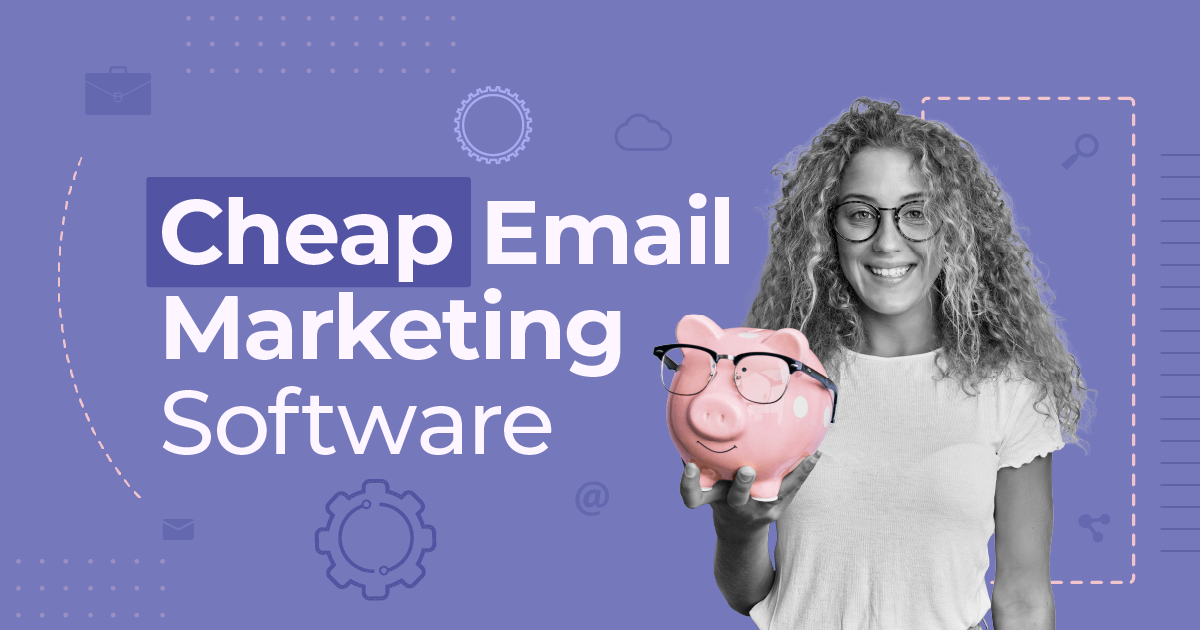
The “No-Sale Sell”: How to Boost Email Engagement Without Discounts
What’s the first thing that pops into your head when you need a quick boost in sales? If your answer is throwing a discount, you’re not alone. But there’s a catch. Do it often, and your customers will start to expect it. Worse, they’ll stop buying, until there’s a new discount.
Brands can boost engagement, create urgency, and increase sales without cutting prices. The “No-Sale Sell” strategy will help you enhance your campaigns with psychological cues and visual elements that make them feel fresh, exclusive, and irresistible.
Why Sending Too Many Discounts Can Hurt Your Business
Everyone loves a good deal, but discount-heavy emails often come with a price. Customers feel reluctant with brands constantly overloading them with discounts and consider their content spammy or non-credible.
Here are some of the negative effects a brand overplaying this tactic faces:
- Decreased product value: Consumers start questioning the true value of your products and services and may assume that prices are inflated.
- Email fatigue: Overflooding subscribers with emails can lead to high unsubscribe rates and spam complaints, putting sender reputation and email deliverability at stake.
- Reduced profit margins: Discounts boost short-term profits but can lead to long-term profit loss if customers purchase only during sales.
- Blurred brand reputation: Customers may start perceiving you as a bargain brand, instead of a premium and high-quality solution.
Thankfully, by delivering value through quality email content and personalized experiences, brands can maintain their credibility and build long-term customer loyalty without relying on discounts.
10 Email Strategies to Increase Engagement Without Discounts
The “No-Sale Sell” email marketing strategy can take many forms based on your goals. Here are 10 converting strategies to delight your audience without discounts for various customer desired actions:
1. Offer personalized product recommendations
Instead of sending discounts in bulk without considering customer information, prefer personalized email campaigns that meet your customers’ needs. Gather important data about your audience, using a CRM solution and email marketing software to target them with relevant messages.
Through dynamic content and custom fields, send relevant product images and descriptions to capture their attention. You can also segment your email lists based on demographics and location, among other factors. For instance, send personalized product recommendations based on purchase history or categories they’ve recently browsed through your website.
Your copywriting should address them directly–phrases such as “Top picks for you” or “You’ll also love” add a personal touch. Want to add a sense of urgency to maximize your email engagement rates? Label your products as seasonal exclusives or soon out-of-stock.
Misfits Market chose a different angle to bring in that effect. They shared the top picks of a head chef to motivate subscribers to go to checkout, capitalizing on the trust necessity:
Subject line: Bobby Flay’s Favorite Finds

Sale emails are usually simple to craft as their main message focuses on the discount. But to grab subscribers’ attention without similar incentives, you need more complex and interesting design.
Moosend offers premade email templates to save time without compromising quality. Plus, it comes with e-Commerce tools, such as automation, dynamic content and behavior tracking to nail personalization.
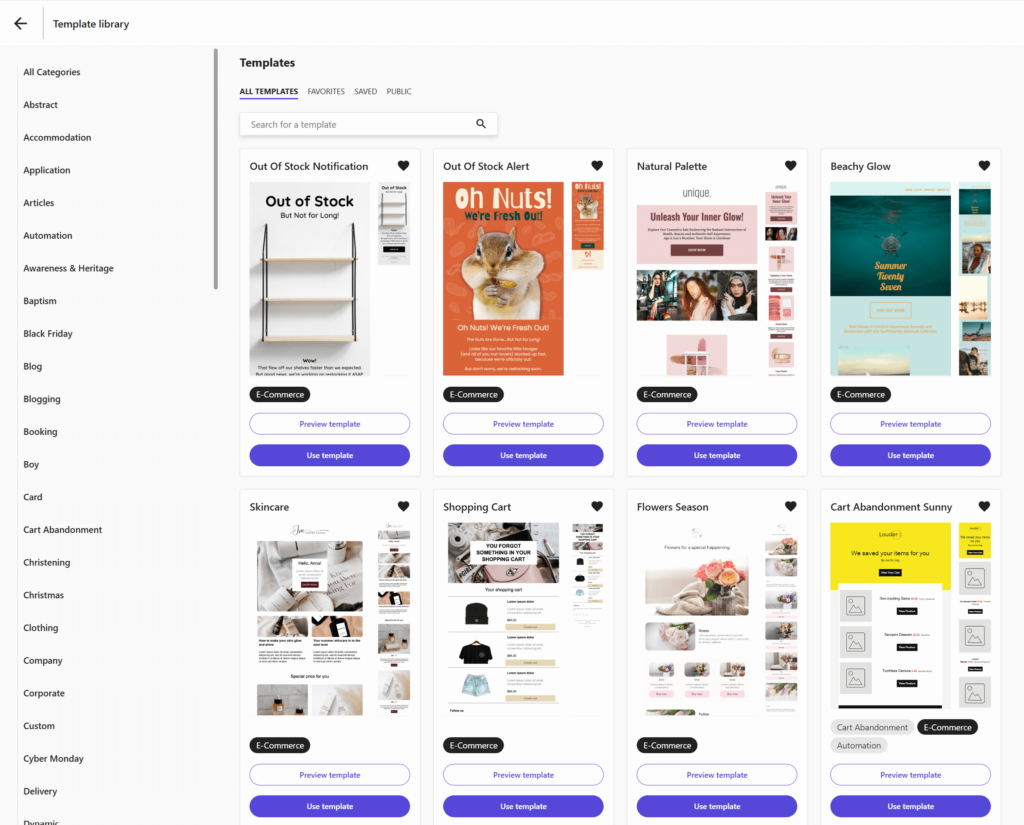
2. Promote best-selling items
Your bestsellers are your business’ biggest assets. Adding them to your email marketing campaigns will entice new subscribers or remind old ones what they might be missing, without exclusive offers needed.
Sharing bestselling products signals to your audience that you want them to have the best of what you offer. Step into their shoes and show them how these products will fit in their life, including the pain points they can tackle. Include reviews, success stories, or use cases and images of people using them to make them visualize the benefits.
To add more urgency, share seasonal bestsellers or gift-guides to boost sales with a copy cue to grab them before they’re gone. Plus, consider adding a best-selling section on welcome emails to increase conversion rates.
Check out this email campaign by Boundary Supply. The combination of best-sellers, reviews, and “Shop now” call-to-actions do the trick. Plus, the emoji on the email subject line can yield more open rates.
Subject line: 🏆 Top Features on Top Sellers

3. Reframe existing products
You don’t need a product launch to grab your subscriber’s attention for good. Instead, reinvent your existing products to give them a new meaning and tie them to a specific theme.
For example, create an email campaign with summer essentials or a Christmas gift guide to drive sales during a high peak season. Product bundles are also popular among consumers. Build a product kit to cater to customers’ needs and save them time from searching for products elsewhere.
When tied with limited time labeling these marketing efforts can yield more sales. To build anticipation, insert a mystery box to direct more people to your website to see the product bundle and get one step closer purchase.
Hawthorne created an amazing Father’s Day email campaign with personalized product bundle recommendations for distinct types of dads, engaging email subscribers to the max. Can you do something similar with your products?
Subject line: Meet our all new dad bundles

4. Send interactive email content
Interactive emails have gained solid ground in the digital marketing world. Through quizzes, polls, and puzzles, subscribers interact with the email content in real-time through hovering, tapping, or clicking. The result? Another great no-sale sell trick to boost email engagement without discounts.
When combined with product recommendations or customer feedback, these email campaigns can boost engagement metrics. For example, new customers can answer a short quiz to find the product that best suits them based on their preferences.
These email types require more coding expertise to set up and functionality that is not supported by all email service providers and ISPs. However, a similar effect can also be replicated with simpler tactics, such as adding a GIF or an infographic with a quick quiz.
Natalist chose a creative way to make the content more interactive by sharing a static quiz with product recommendations for different needs:
Subject line: Guess what? It’s quiz time!

5. Create urgency without dropping prices
Incentives such as flash sales or exclusive offers create a sense of urgency and boost click-through rates and conversions. You can also instill that FOMO effect and direct customers to checkout using other techniques, keeping discounts for sales periods, such as Black Friday or summer.
Early access to limited edition or new products can motivate subscribers to buy. These initiatives are great for loyal customers as they create a sense of exclusivity. Add a countdown timer to show when access their will be over to double that effect.
Send back-in-stock emails for best-sellers or customers’ favorite products to incentivize customers to claim them before they’re gone. Sending timely seasonal emails, such as on Mother’s or Valentine’s Day, with gift guides and recommendations can also yield sales. Create follow-ups for disengaged or last-minute customers, offering more options, such as gift cards to cater to different needs.
Here’s a fitting example from 1906 New Heights. Their back-in-stock email is enhanced with an urgent CTA followed by a “Don’t wait for them to sell out again” note.
Subject line: BACK IN STOCK: Pain Gummies
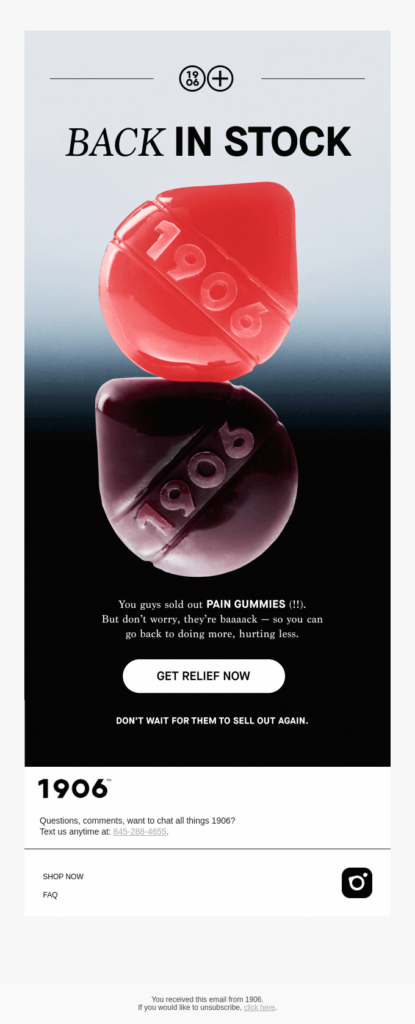
6. Announce upcoming product drops
Product announcement emails can build excitement around new entries, make subscribers root for them, and even add them to cart. Introduce your product drops through visually appealing emails with high-quality images.
To make it even more engaging, send a teaser email with a countdown timer to create mystery around upcoming products. You don’t need to show the products in this phase, just share some hints to make it more fun. Promote the teaser on other platforms, such as social media to gain more traction.
You can also build a waitlist to send follow-ups to specific subscribers excited about the new products and highly likely to purchase them. Or give early access to VIP customers to boost their loyalty.
Here’s a great teaser email example by Nissan:
Subject line: It’s a masterpiece you have to see
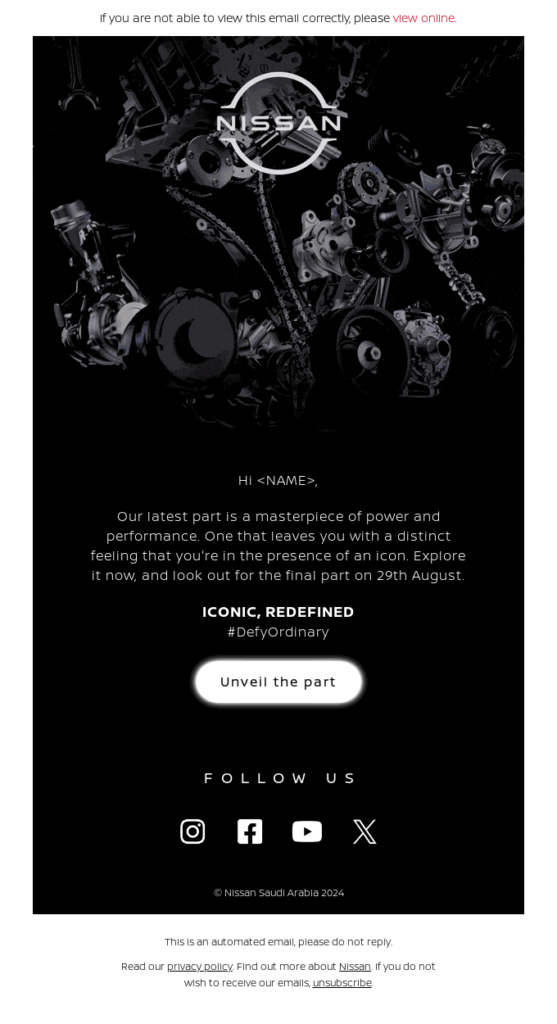
7. Refresh your email design
Using the same email design and elements is good for consistency. But when subscribers see the same email again and again their brains tune out. That’s why it’s important to make slight changes to revamp your email style without altering your core messaging.
For example, try new seasonal colors or enhance your email design with a GIF. You can also use dynamic content to share relevant images to readers based on certain factors, such as demographics or preferences, to build email engagement without discounts needed.
If you’re unsure about new visual elements, use A/B testing to see what works best for your audience. Plus, ensure that images or interactive elements are responsive for mobile devices to maintain a great user experience.
To diversify their email style, Starbucks dressed up in Christmas colors to join the festive spirit and delight the audience, sticking to their color palette:
Subject line: Get holiday faves + a 🎁 tomorrow!

8. Create educational content
Consumers get confused when receiving product recommendations and discounts from a brand regularly and become suspicious of the brand’s intents. Instead of overflooding them with promotion-heavy emails, show them how to make the most of your products through educational email campaigns.
Sync your email and content marketing tools to go in-depth with valuable tips or information about your product. You can also use marketing automation tactics to create a nurturing email series with tutorials. For example, a beauty brand can create a sequence with information about their skincare ingredients, benefits, and beauty tips to make the audience wait for more.
Moosend recently announced the website redesign with an email series, showing our customers how to use the platform features to revamp their emails:
Subject line: ✨ Makeover Alert: Ready to Wow?
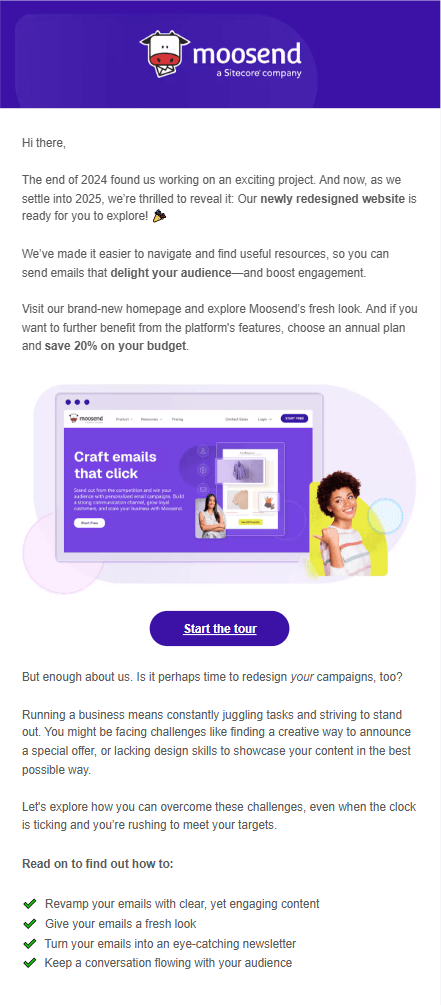
9. Send customer testimonials
Social proof is an important conversion tool. It helps win the audience’s trust and yield sales faster, without needing coupons or discounts. Sharing reviews or testimonials on emails is a great way to build engagement.
Focus on customer reviews highlighting the benefits of your products or services. You can also partner with influencers with a similar target audience to earn more trust points. If you’re in B2B, share case studies or scores from review sites such as G2.
Apart from sending dedicated review email campaigns, add social proof on other promotional emails as well. For instance, place them next to product recommendations or re-engagement emails to win people back.
Expert input is always a great addition. Bubble shared reviews from dermatologists to show their product formulas are clinically proven:
Subject line: DERMS KNOW BEST…

10. Evoke emotion through storytelling
Good emails don’t have to be product oriented. Storytelling can enhance all types of emails despite their intent. Regarding engagement, story-based emails can move your readers and make them fond of your brand.
Start by sharing story-based campaigns during important celebrations, such as Thanksgiving or Christmas, or certain milestones, such as company anniversaries, to see how subscribers react. Plus, honor customer turning points, such as one year since the first purchase.
Finally, share personal stories as WeTransfer did to inspire your audience:
Subject line: A set of stories to kickstart your ideas

Begin Your No-Sale Sell Journey
Which tactic from the above would you implement first and how would you enhance it? Think of your target audience and what appeals to them to craft email campaigns that leave a lasting impression, without hurting your long-term profit.
Finally, schedule re-engagement campaigns to maximize conversions and practice different tactics to see what works best. When consistency meets variety, conversion is steady.
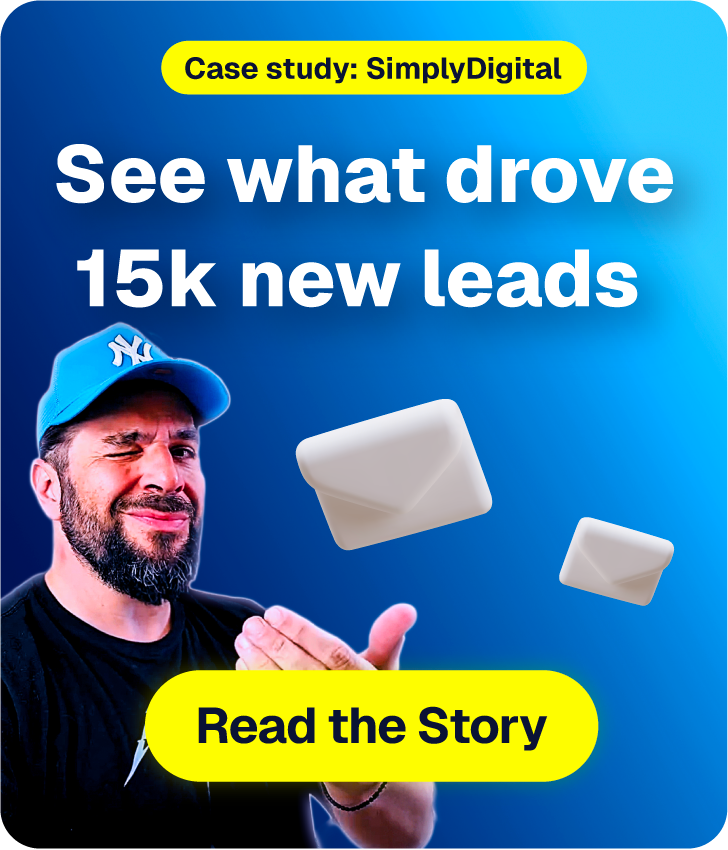

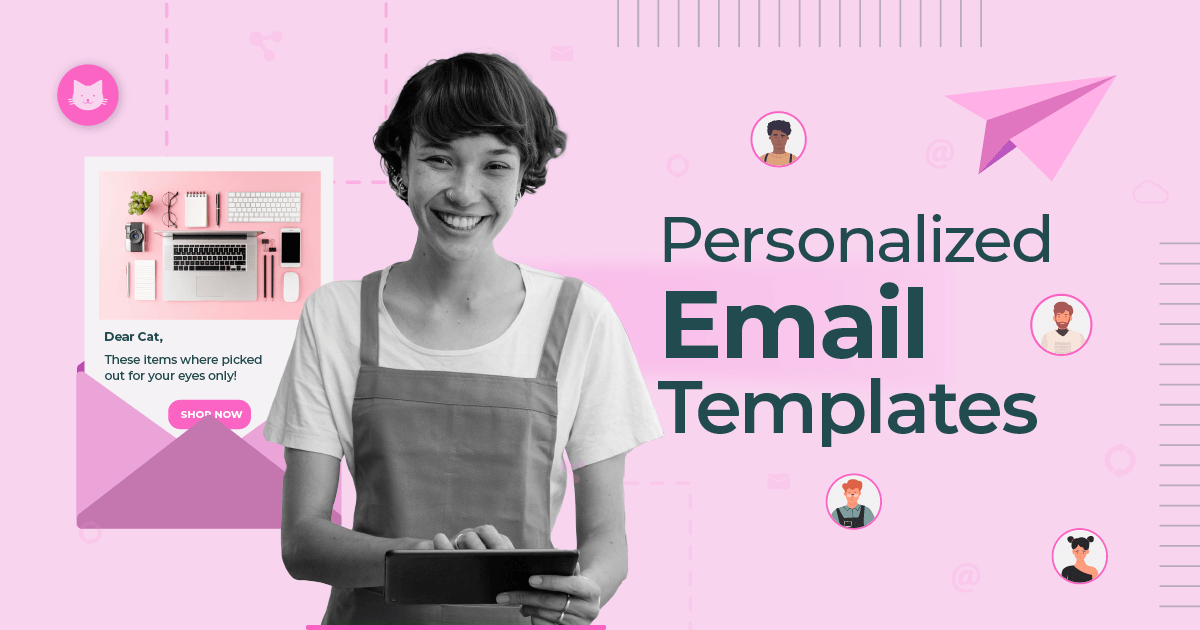
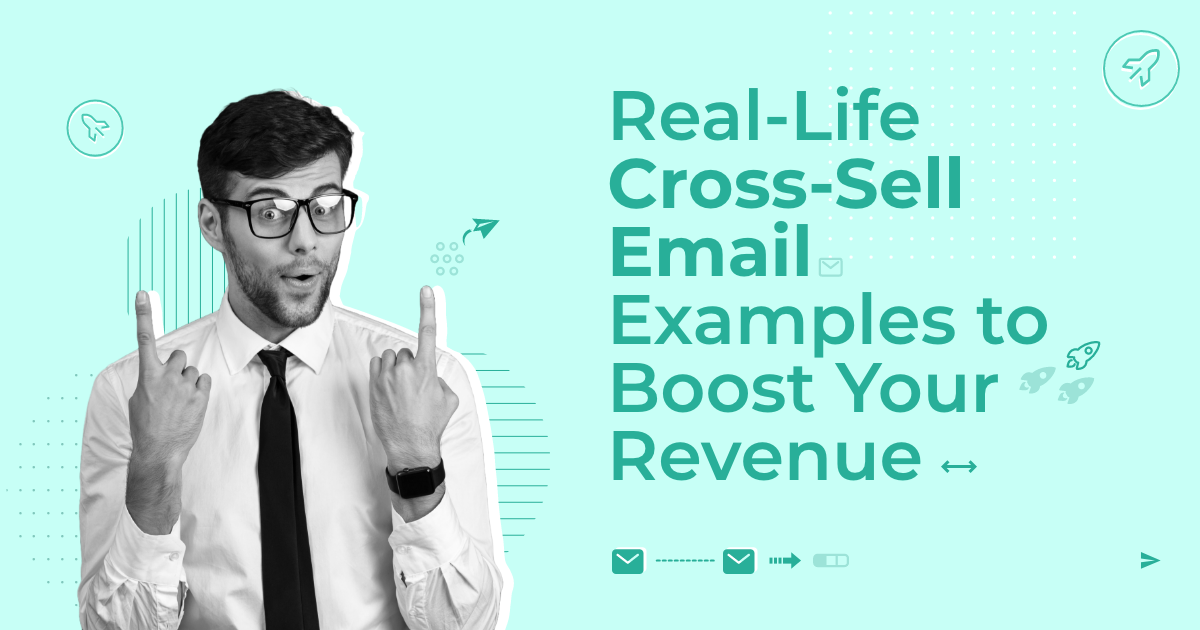
 Published by
Published by
